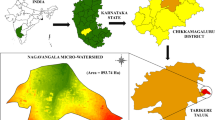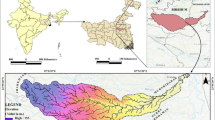Abstract
Soil resource is important for livelihood of the human being. Soil erosion is a global environmental crisis in the world today that threatens the natural environment and agriculture. The present study was undertaken to assess the annual rate of soil erosion from the study watershed using distributed information for topography, land use, soil, etc. using remote sensing (RS) and geographic information system (GIS) techniques and to compare the simulated sediment loss with observed sediment loss. In the present study, the Shakkar River watershed, lying in Narmada river basin situated in Narsinghpur and Chhindwara districts of Madhya Pradesh, India, was selected. The universal soil loss equation (USLE) integrated with RS and GIS approach was used to predict the spatial distribution of the soil erosion on a cell basis occurring in the study area. Thematic maps of USLE factors like rainfall erosivity factor (R), soil erodibility factor (K), topographic factor (LS), crop/cover management factor (C), and conservation/support practice factor (P) were prepared by using annual rainfall data, soil map, digital elevation model (DEM) and executable C++ program, and satellite image of the area, respectively, in the GIS environment. The annual rate of soil erosion was estimated for 10 years (1997 to 2006), and during this period, the annual rate of sediment loss from study area was found to vary between 6.45 and 13.74 t/ha/year with an average annual rate of 10.04 t/ha/year. The percent deviation between simulated and observed values varies between 2.68 and 18.73 % with coefficient of determination (R 2) of 0.911.















Similar content being viewed by others
References
Aggarwal SP, Desilva RP, Mohamed Rinos MH (2000) Application of remote sensing and GIS on soil erosion assessment at Bata River Basin, India. Natural Hazard Management Booklet
Alejandra MR (2008) Soil erosion calculation using remote sensing and GIS in Río Grande De Arecibo watershed, Puerto Rico. Proceedings of ASPRS Annual Conference, Portland, Oregon
Arar A, Chenchouni H (2014) A simple geomatics-based approach for assessing water erosion hazard at montane areas. Arab J Geosci 7(1):1–12
Asis AM, Omasa K (2007) Estimation of vegetation parameter for modeling soil erosion using linear spectral mixture analysis of Landsat ETM data. ISPRS J Photogramm Remote Sens 62(4):309–324
Babu R, Dhyani BL, Kumar N (2004) Assessment of erodibility status and refined iso-erodent map of India. Indian J Soil Conserv 32(3):171–177
Bagherzadeh A (2014) Estimation of soil losses by USLE model using GIS at Mashhad plain, Northeast of Iran. Arab J Geosci 7(1):211–220
Bingner RL, Murphee CE, Mutchler CK (1989) Comparison of sediment yield models on various watersheds in Mississippi. Trans ASAE 32(2):529–534
Cohen MJ, Shepherd KD, Walsh MG (2005) Empirical reformulation of the Universal Soil Loss Equation for erosion risk assessment in a tropical watershed. Geoderma 124(3–4):235–252
Dabral PP, Baithuri N, Pandey A (2008) Soil erosion assessment in a hilly catchment of North Eastern India using USLE, GIS and remote sensing. Water Resour Manag 22:1783–1798
Das DJ (2008) Identification of critical erosion prone areas for watershed prioritization using GIS and remote sensing. Dissertation, Indian Institute of Technology Roorkee
Desilva RP, Dayawansa NDK, Jayarathne KDBL (2010) GIS based analysis of biophysical and socio-economic factors for land degradation in Kandaketiya DS division. Trop Agric Res 21(4):361–367
FAO/UNEP (1994) Land degradation in south Asia: its severity causes and effects upon the people. FAO & UNEP, Rome
Fernandez C, Wu JQ, McCool DK, Stockle CO (2003) Estimating water erosion and sediment yield with GIS, RUSLE, and SEDD. J Soil Water Conserv 58(3):128–136
Fistikoglu O, Harmancioglu NB (2002) Integration of GIS with USLE in assessment of soil erosion. Water Resour Manag 16:447–467
Gajbhiye S, Mishra SK, Pandey A (2014) Simplified sediment yield index model incorporating parameter curve number. Arab J Geosci. doi:10.1007/s12517-014-1319-9
Gitas IZ, Douros K, Minakou C, Silleos GN, Karydas CG (2009) Multi-temporal soil erosion risk assessment in North Chalkidiki using a modified USLE raster model. EARSeL eProceedings 8:40–52
Global Land Cover Facility (GLCF) (2000) http://glcfapp.umiacs.umd.edu. Accessed 10 Aug 2012
Hickey R (2000) Slope angle and slope length solutions for GIS. Cartography 29(1):1–8
Hudson N (1995) Runoff, erosion and sedimentation: prediction and measurement. Int FAO edn. Land and Water Integration and River Basin Management, FAO Land & Water Bulletin 1(85)
Hydrological Data Directorate (2006) Integrated hydrological data book. Water planning and projects wing. Central Water Commission, New Delhi
Hydrological Data Directorate (2012) Integrated hydrological data book. Water planning and projects wing. Central Water Commission, New Delhi
International Association of Mathematical Geosciences (IAMG). http://www.iamg.org. Accessed 15 Sept 2012
Jain SK, Goel MK (2002) Assessing the vulnerability to soil erosion of the Ukai Dam catchment using remote sensing and GIS. Hydrol Sci J 47(1):31–40
Jain MK, Kothyari UC (2000) Estimation of soil erosion and sediment yield using GIS. Hydrol Sci J 45(5):771–786
Jones RJA, Montanarella L, Van der Knijff JM (1996) Soil erosion risk assessment in Italy. Space Applications Institute, European Soil Bureau
Julien YP, Tanago MGD (1991) Spatially varied soil erosion under different climates. Hydrol Sci J 36(6):511–524
Kavian A, Azmoodeh A, Solaimani K (2014) Deforestation effects on soil properties, runoff and erosion in northern Iran. Arab J Geosci 7:1941–1950
Khosrokhani M, Pradhan B (2014) Spatio-temporal assessment of soil erosion at Kuala Lumpur metropolitan city using remote sensing data and GIS. Geomatics Nat Hazards Risk 5(3):252–270
Khosrowpanah S, Heitz LF, Wen Y, Park M (2007) Developing a GIS-based soil erosion potential model of the Ugum watershed. Water and Environmental Research Institute, Western Pacific UOG Station, Guam, Technical Report No. 117
Kothyari UC, Jain MK, Ranga Raju KG (2002) Estimation of temporal variation of sediment yield using GIS. Hydrol Sci J 47(5):693–706
Mandal D, Sharda VN (2011) Assessment of permissible soil loss in India employing a quantitative bio-physical model. Curr Sci 100(3)
McCool DK, Brown LC, Foster GR (1987) Revised slope steepness factor for the USLE. Trans ASAE 30:1387–1396
Mishra RN, Bhist SS, Chandra Sekhar M (2003) Watershed management—a perspective. Allied Publishers, New Delhi, pp 151–163
Mosbahi M, Benabdallah M, Boussema RM (2013) Assessment of soil erosion risk using SWAT model. Arab J Geosci 6:4011–4019
NBSSLUP (1996) Soils of Madhya Pradesh for optimizing land use. Publication 50(b)
Pandey A, Chowdary VM, Mal BC (2007) Identification of critical erosion prone areas in the small agricultural watershed using USLE, GIS and remote sensing. Water Resour Manag 21(4):729–746
Parveen R, Kumar U (2012) Integrated approach of Universal Soil Loss Equation (USLE) and Geographical Information System (GIS) for soil loss risk assessment in upper South Koel Basin, Jharkhand. J Geogr Inf Sci 4:588–596
Patil RJ, Sharma SK (2013) Estimation of crop management factor (C) of Universal Soil Loss Equation for soil erosion modeling using RS and GIS techniques in Shakkar river watershed, Chhindwara, Madhya Pradesh, India. JNKVV Res J 47(1):111–115
Phillip JD (1990) Relative importance of factors influencing fluvial soil loss at global scale. Am J Sci 290:547–568
Pradhan B, Chaudhari A, Adinarayana J, Buchroithner MF (2012) Soil erosion assessment and its correlation with landslide events using remote sensing data and GIS: a case study at Penang Island, Malaysia. Environ Monit Assess 184(2):715–727
Rawat KS, Tripathi VK, Mishra AK (2014) Sediment Yield Index mapping and prioritization of Madia subwatershed, Sagar District of Madhya Pradesh (India). Arab J Geosci 7(8):3131–3145
Saha SK, Kudarat M, Bhan SK (1992) Erosion soil loss prediction using digital satellite data and universal soil loss equation–soil loss mapping in Siwalik Hills in India. In: Shunji M (ed) Application of remote sensing in Asia and oceanic–environmental change monitoring. Asian Association on Remote Sensing, pp 369–372
Saumer P, Schonbrodt S, Behrens T, Seeber C, Scholten T (2010) Assessing the USLE crop and management factor C for soil erosion modeling in a large mountainous watershed in Central China. J Earth Sci 21(6):835–845
Sharma SK, Pathak R, Suraiya S (2012) Prioritization of sub-watersheds based on morphometric analysis using remote sensing and GIS technique. JNKVV Res J 46(3):407–413
Sheikh A, Palria HS, Alam A (2011) Integration of GIS and universal soil loss equation (USLE) for soil loss estimation in a Himalayan watershed. Recent Res Sci Technol 3(3):51–57
Shin GJ (1999) The analysis of soil erosion in watershed using GIS. Dissertation, Gang-won National University
Shrestha DP (1997) Assessment of soil erosion in the Nepalese Himalaya—a case study in Likhu Khola valley, Middle Mountain Region. Land Husb 2(1):59–80
Singh PK (2000) Watershed management (design and practices). e-media publications, Udaipur
Singh G, Babu R, Narain P, Bhusan LS, Abrol IP (1992) Soil erosion rates in India. J Soil Water Conserv 47(1):97–99
Staples C, Ahmed S, Ewers RM (2012) Sensitivity of GIS patterns to data resolution: a case study of forest fragmentation in New Zealand. N Z J Ecol 36(2):203–209
Subramanya K (2009) Engineering hydrology. Tata McGraw-Hill, New Delhi
Vaezi AR, Bahrami HA, Sadeghi SHR, Mahdian MH (2011) Developing a nomograph for estimating erodibility factor of calcareous soils in North West of Iran. Int J Geol 5(4):93–100
Van Remortel R, Maichle R, Hickey R (2004) Computing the RUSLE LS factor based on array-based slope length processing of digital elevation data using a C++ executable programme. Comput Geosci 30(10):1043–1053
Wischmeier WH, Smith DD (1965) Predicting rainfall-erosion losses from cropland east of Rocky Mountains: guide for selection of practices for soil and water conservation. USDA Agricultural Handbook, p 282
Wischmeier WH, Smith DD (1978) Predicting rainfall-erosion losses—a guide to conservation planning. USDA Agricultural Handbook 537, Washington DC, p 57
Young RA, Onstad CA, Bosch DD, Anderson WP (1987) AGNPS: an agriculture nonpoint source pollution model. Conservation Research Report 35. USDA Agricultural Research Services, Washington DC
Zivotic L, Perovic V, Jaramaz D, Dordevic A, Petrovic R, Todorovic M (2012) Application of USLE, GIS, and remote sensing in the assessment of soil erosion rates in South Eastern Serbia. Pol J Environ Stud 21(6):1929–1935
Further reading
ERDAS IMAGINE Tour Guides, ERDAS IMAGINE Field Guides, ERDAS IMAGINE V 8.5 (2001) Inc Atlanta, Georgia, USA
ESRI (Environmental Systems Research Institute) (1994) Cell based modeling with grid. Environmental Systems Research Institute, USA
Acknowledgments
The authors acknowledge all the support received from the Department of Soil and Water Engineering, College of Agricultural Engineering, Jawaharlal Nehru Krishi Vishwa Vidyalaya, Jabalpur (MP), India for this study. The authors would also like to thank the anonymous reviewers whose valuable comments/suggestions led to a substantially improved manuscript.
Author information
Authors and Affiliations
Corresponding author
Rights and permissions
About this article
Cite this article
Patil, R.J., Sharma, S.K. & Tignath, S. Remote Sensing and GIS based soil erosion assessment from an agricultural watershed. Arab J Geosci 8, 6967–6984 (2015). https://doi.org/10.1007/s12517-014-1718-y
Received:
Accepted:
Published:
Issue Date:
DOI: https://doi.org/10.1007/s12517-014-1718-y




